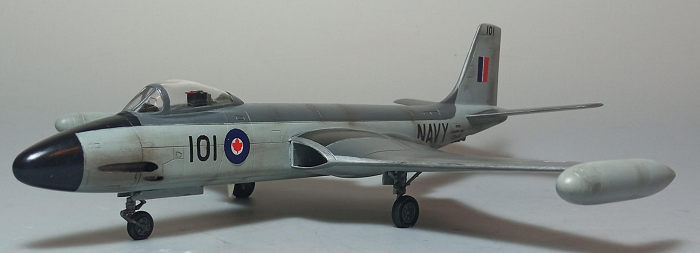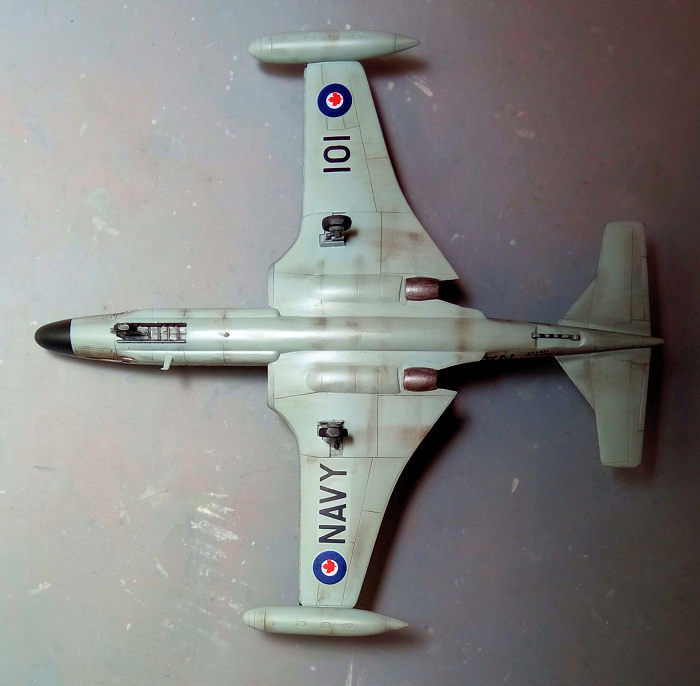
Hobbycraft 1/72 F2H-3 Banshee
| KIT #: | HC 1397 |
| PRICE: | $10.00 when new |
| DECALS: | Two options |
| REVIEWER: | Spiros Pendedekas |
| NOTES: | 1987 release |

| HISTORY |
With its name derived
from Irish mythology, the McDonnell F2H Banshee was an early jet fighter
operated by the United States Navy, the United States Marine Corps and the Royal
Canadian Navy.
The Banshee was developed during the mid to late 1940s, being a larger, more
powerful and more heavily armed derivative of the earlier FH Phantom and
incorporating several innovations, such as a pressurized cockpit, a "kneeling"
nose landing gear and an ejection seat. It was one of the primary American
fighters used in the Korean War, typically being flown as an escort fighter and
reconnaissance aircraft. Radar-equipped Banshees were also used for all-weather
fleet defense.
 Albeit
(mainly due to its straight wing) being considerably slower than the latest
land-based fighters, with its powerful twin jets, its high rate of climb, its
ruggedness and resistance to flak and easy maintainability it proved to be a
capable high-altitude fighter, making it the aircraft of choice to escort B-29
bombers over Korea. In total, 895 examples were built.
Albeit
(mainly due to its straight wing) being considerably slower than the latest
land-based fighters, with its powerful twin jets, its high rate of climb, its
ruggedness and resistance to flak and easy maintainability it proved to be a
capable high-altitude fighter, making it the aircraft of choice to escort B-29
bombers over Korea. In total, 895 examples were built.
In 1951, the Royal Canadian Navy (RCN) drafted a $40 million deal for 60 new
Banshees to replace its obsolete fleet of Hawker Sea Furies. As the purchase was
not approved before 1953, by which point production of the Banshee had been
terminated, the RCN resorted to acquiring 39 second-hand USN F2H-3s for $25
million which were delivered between 1955 and 1958. They would be flown from
HMCS Bonaventure, as well as NORAD interceptors from shore bases. RCN
systematically equipped their aircraft with AIM-9 Sidewinders, in order to
increase their potential.
Although initially well-liked by Canadian pilots for its flying qualities, the
Banshee exhibited a high accident rate of 30.8%. This, combined with RCN’s shift
to anti-submarine warfare (ASW), which did not anticipate aerial attacks
(meaning here was little need for the type) and escalated costs to keep the
obsolete bird operational in the harsh Atlantic environment, quickly gave the
death’s kiss to Canadian Banshees, which were retired without replacement in
September 1962.
The short lived Canadian Banshees were the primary aircraft of the equally
short-lived RCN Grey Ghosts aerobatic team that flew available operational
Banshees for each show. Three RCN Banshees survive to date, with the rest either
scrapped or burned in firefighting exercises upon their retirement.
| THE KIT |
 This is the
late 80s Hobbycraft mold that has lately been recently reissued by Academy.
Essentially an upgrade of the older Airfix offering, it is a solid kit,
providing a decent representation of the F2H-3, having its strong points (sharp
molding, well done engraved panel lines, looks accurate) and lacking at areas
like the too shallow wheel wells and the off-registered decals at the earlier
reboxings, with the detail at the rest key areas (like the cockpit, engine and
landing gear parts) being average.
This is the
late 80s Hobbycraft mold that has lately been recently reissued by Academy.
Essentially an upgrade of the older Airfix offering, it is a solid kit,
providing a decent representation of the F2H-3, having its strong points (sharp
molding, well done engraved panel lines, looks accurate) and lacking at areas
like the too shallow wheel wells and the off-registered decals at the earlier
reboxings, with the detail at the rest key areas (like the cockpit, engine and
landing gear parts) being average.
The specific kit is the original 1987 release and was bought in 2004 from a (now
sadly closed) toy/hobby shop in my hometown at a fairly low price. For a look at
its contents, you may read its preview,
found at the ever growing MM archives.
| CONSTRUCTION |
I started by trapping
the cockpit tub, rear bulkhead and instrument panel between the fuselage halves,
together with some 15 grams of fishing weights in the front, to prevent tail
sitting. The intake inner plates were attached at this time, as well. The wings,
which contain the root-fitted engines, were next assembled (a five-piece affair
each) and attached to the fuselage.
Basic cockpit color was black, with the raised instrument faces dry brushed with
silver and some red, yellow and white knobs “pinned” with a toothpick with like
colors. The seat and control stick were left off, to be attached at later
stages. The intakes and compressor faces were painted Tamiya X-11 Silver.
The tail planes were next, which must be attached at an upward angle, followed
by the 2-piece tip tanks, which were also attached, needing some tweaking to sit
positively and correctly (and I think I did a less than perfect job there…).
Since light could be seen passing through the fuselage gun holes, I stuffed
some modeling clay fore of the cockpit, which I carefully painted black by
inserting a fine brush through the gun openings.
This concluded basic assembly which was as pleasant and uncomplex as the kit
itself is. Overall fit, while not “Tamiya”, was good, only needing some filler
at the “usual suspect” areas (mainly the wing roots). A couple of sink areas
were filled too. After a final sanding, I decided to take the Banshee to the
paint shop!
| COLORS & MARKINGS |
 Deciding to
go for a Canadian bird, I first gave the nose and front anti glare area a coat
of Hu85 Black, then masked it off and gave the topsides a coat of Hu123 Extra
dark Sea Gray. After masking it too, I gave the remaining a coat of Hu127 US
Ghost Gray. Upon removing the masks, I painted the exhausts, as well as the
front gun openings, Mr Hobby 61 Burnt Iron. The distinctive “Corroguard” coated
leading edges were hand painted with Hu56 Aluminum, which dried to a shade close
to that observed in reality. A coat of Future prepared the bird for decals.
Deciding to
go for a Canadian bird, I first gave the nose and front anti glare area a coat
of Hu85 Black, then masked it off and gave the topsides a coat of Hu123 Extra
dark Sea Gray. After masking it too, I gave the remaining a coat of Hu127 US
Ghost Gray. Upon removing the masks, I painted the exhausts, as well as the
front gun openings, Mr Hobby 61 Burnt Iron. The distinctive “Corroguard” coated
leading edges were hand painted with Hu56 Aluminum, which dried to a shade close
to that observed in reality. A coat of Future prepared the bird for decals.
I use the kit decals, in order to represent #101 RCN machine, as it stood
sometime in the late 50s. Decals were neither sharply printed nor well
registered, this being especially true for the red maple leaves. At least they
behaved well in application, easily detaching from their backing paper and, with
the help of strong softening solution, more or less following the contours of
the model. A coat of Future sealed them.
| FINAL BITS |
The seat, stick, as well
as a simple gunsight made from acetate sheet were attached in position. In order
to beef up the looks of the simplistic ejection seat, I added foot pans from
styrene sheet, ejection handles from stretched sprue and seat belts from masking
tape. Basic seat frame and head cushion color was black, the rear and lower
cushions were olive green, all three ejection handles were red and seat belts
were left unpainted with brass buckles done with a fine tip brass pen.
All landing gear parts were next attached, with the bird proudly standing on its
feet. The nose leg that contained the wheel not only was too short, but also had
the wrong shape, being more correct for earlier Banshees. By consulting net
available pics, I cut off and repositioned its bits and also added a longer main
strut from styrene of suitable thickness, in order to give the Banshee a slight
nose up stance. I also added brake lines to the main legs and some ribbing to
the nose bay from stretched sprue, hoping to somehow distract the foc using
on the too shallow bays. All landing gear parts, wheel wells, door innards and
wheel rims were painted Hu56 Aluminum, tires and brake lines were black, brake
calipers were painted gunmetal. Oleos were highlighted with a fine tip silver
pen. The wheels were tad filed to look weighted.
using
on the too shallow bays. All landing gear parts, wheel wells, door innards and
wheel rims were painted Hu56 Aluminum, tires and brake lines were black, brake
calipers were painted gunmetal. Oleos were highlighted with a fine tip silver
pen. The wheels were tad filed to look weighted.
Time for some weathering, which first consisted of a black wash to accentuate
all recessed panel lines and provide some areas (like the landing gear) with a
used, oily look. Then, dark brown and black dry pastels were applied at all
areas where dirt, grime and the like would likely reside, with a satin coat
giving the bird its final hue.
The canopy had its well defined frames hand painted and attached in position.
Though it fitted well at both front and rear, a gap was evident in the middle
area, which was treated with white glue. The underside antenna was painted white
and attached at this time, as well.
The distinctive pitot tube which was mounted on the lower starboard side of the
fuselage front was not provided by the kit and was fabricated from a suitably
cut styrene sheet with a stretched sprue piece glued on its end. Finally, tiny
blobs of red and green clear paint represented the wingtip lights, before
calling the Canadian Banshee done!
| CONCLUSIONS |
Sword came in 2014 with
its sensibly priced 1/72 Banshees (still, as of 2024, to offer the -3 though),
which offer a high level of detail (you can read Rob Hart’s nice preview of the
F2H-2P here).
Being limited run in nature and containing resin and (a lot of) PE parts means
that they are not expected to be easy builds, but if you want a modern, detailed
and accurate Banshee they are the way to go.
This means that the subject elderly Hobbycraft (now boxed by Academy) Banshee is
now left in second place (with the even older Airfix following), still being a
solid kit, with its strengths and weaknesses. On the one hand, overall shape
looks correct, molding is sharp, panel lines are finely engraved, construction
is uncomplex and fit is good. On the other hand, key area detailing is average,
landing gear bays are way too shallow and decals were off registered (not an
issue at the recent Academy reboxing, though).
Out of the box, an attractive Banshee can still emerge. Offered at a good
fraction of the price of the superior but challenging Sword, this is still a
decent albeit simple kit that can yield an appealing result.
Happy Modeling!
Spiros Pendedekas
5 August 2024
Copyright ModelingMadness.com. All rights reserved. No
reproduction in part or in whole without express permission.
If you would like your product reviewed fairly and fairly
quickly, please
contact
the editor or see other details in the
Note to
Contributors.